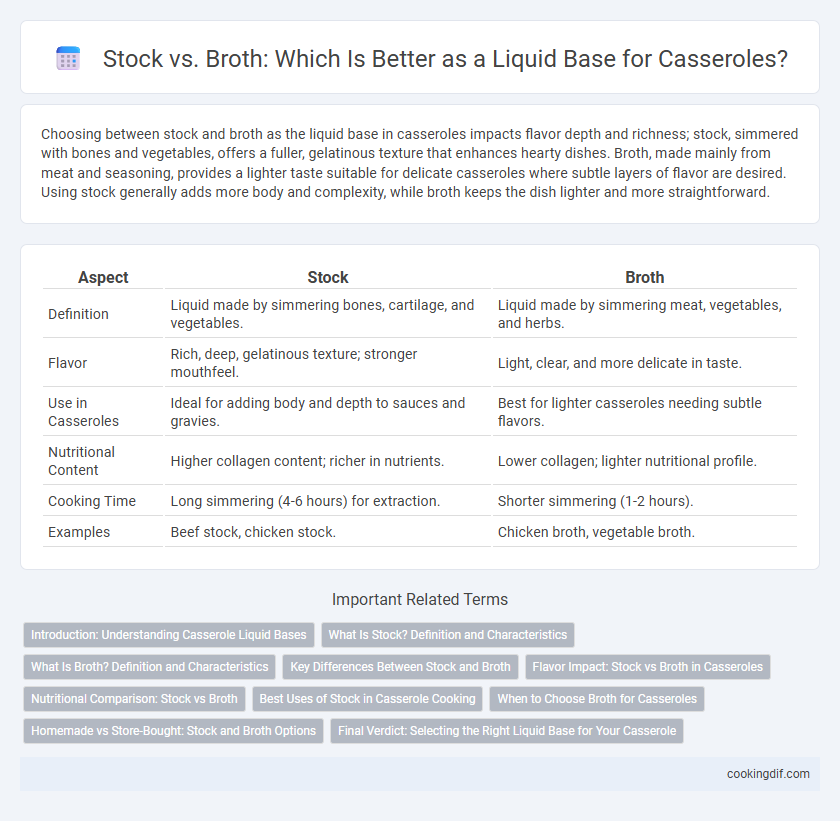Choosing between stock and broth as the liquid base in casseroles impacts flavor depth and richness; stock, simmered with bones and vegetables, offers a fuller, gelatinous texture that enhances hearty dishes. Broth, made mainly from meat and seasoning, provides a lighter taste suitable for delicate casseroles where subtle layers of flavor are desired. Using stock generally adds more body and complexity, while broth keeps the dish lighter and more straightforward.
Table of Comparison
| Aspect | Stock | Broth |
|---|---|---|
| Definition | Liquid made by simmering bones, cartilage, and vegetables. | Liquid made by simmering meat, vegetables, and herbs. |
| Flavor | Rich, deep, gelatinous texture; stronger mouthfeel. | Light, clear, and more delicate in taste. |
| Use in Casseroles | Ideal for adding body and depth to sauces and gravies. | Best for lighter casseroles needing subtle flavors. |
| Nutritional Content | Higher collagen content; richer in nutrients. | Lower collagen; lighter nutritional profile. |
| Cooking Time | Long simmering (4-6 hours) for extraction. | Shorter simmering (1-2 hours). |
| Examples | Beef stock, chicken stock. | Chicken broth, vegetable broth. |
Introduction: Understanding Casserole Liquid Bases
Choosing between stock and broth as the liquid base in casseroles significantly impacts flavor depth and richness. Stock, simmered with bones and connective tissues, offers a thicker, gelatinous texture and more concentrated taste, enhancing savory dishes. Broth, made primarily from meat and vegetables, provides a lighter, clearer liquid ideal for delicate casseroles needing subtle seasoning.
What Is Stock? Definition and Characteristics
Stock is a flavorful liquid made by simmering bones, vegetables, and aromatics in water, providing a rich foundation for casseroles. It contains collagen from bones, which adds body and depth to the dish, enhancing the overall texture and taste. Unlike broth, stock is typically unseasoned and more gelatinous, making it ideal for creating savory casseroles with a robust and hearty flavor profile.
What Is Broth? Definition and Characteristics
Broth is a savory liquid made by simmering meat, vegetables, and aromatics in water, often seasoned and strained before use. It features a lighter texture and more delicate flavor compared to stock, which is typically richer and gelatinous due to collagen from bones. Broth serves as a flavorful base in casseroles, enhancing the overall taste without overpowering other ingredients.
Key Differences Between Stock and Broth
Stock and broth serve as foundational liquids in casseroles, but they differ significantly in preparation and flavor intensity. Stock is made by simmering bones, vegetables, and aromatics, resulting in a richer, gelatinous texture ideal for adding depth and body to casseroles. Broth is prepared primarily from meat and vegetables, producing a lighter, cleaner flavor that enhances casseroles without overwhelming other ingredients.
Flavor Impact: Stock vs Broth in Casseroles
Stock delivers a richer, more concentrated flavor profile in casseroles due to its slow-simmered bones and aromatics, enhancing the depth and complexity of the dish. Broth, made primarily from simmered meat and vegetables, imparts a lighter, more delicate taste that allows other casserole ingredients to shine without overpowering them. Choosing stock elevates casseroles with robust umami and gelatinous texture, while broth offers a subtler, cleaner liquid base for balanced flavor layering.
Nutritional Comparison: Stock vs Broth
Stock typically contains higher concentrations of minerals and collagen extracted from simmered bones, providing greater nutritional benefits like calcium, magnesium, and gelatin. Broth, made primarily from simmered meat and vegetables, tends to have a lighter nutrient profile with more protein but fewer minerals compared to stock. Choosing stock as a liquid base in casseroles enhances flavor depth and delivers superior joint-supporting nutrients, while broth offers a more delicate taste with moderate protein content.
Best Uses of Stock in Casserole Cooking
Stock, rich in collagen and gelatin from simmered bones, provides a deep, savory foundation ideal for casseroles requiring a thick, velvety consistency. Using stock enhances the umami profile and mouthfeel of dishes like pot pies and baked pasta casseroles, where prolonged oven cooking concentrates flavors. Its nutrient-dense composition also enriches slow-cooked casseroles, delivering a robust taste that broth, typically lighter and seasoned, cannot match.
When to Choose Broth for Casseroles
Broth is ideal for casseroles when a richer, more flavorful liquid base is desired, as it brings depth from simmered bones, vegetables, and herbs. It enhances dishes like chicken casseroles or vegetable bakes, adding natural umami without overpowering other ingredients. Choose broth over stock when clarity and a lighter taste are preferred, complementing delicate flavors in creamy or cheesy casseroles.
Homemade vs Store-Bought: Stock and Broth Options
Homemade stock offers a richer, more complex flavor with natural gelatin and nutrients extracted from simmered bones and vegetables, enhancing the depth of casseroles. Store-bought broth provides convenience with a lighter taste, often containing added sodium and preservatives that can influence the overall seasoning balance. Choosing homemade stock improves texture and nutritional value, while store-bought broth delivers time-saving consistency for quick casserole preparations.
Final Verdict: Selecting the Right Liquid Base for Your Casserole
Stock enhances casseroles with a richer, deeper flavor and a more gelatinous texture due to its collagen content, making it ideal for slow-cooked dishes. Broth offers a lighter, clearer base with a subtler taste, suitable for casseroles where delicate flavors or less intense seasoning is desired. Choosing stock or broth depends on the desired depth of flavor and dish complexity, with stock preferred for hearty casseroles and broth for lighter, more aromatic preparations.
Stock vs broth for liquid base Infographic

 cookingdif.com
cookingdif.com